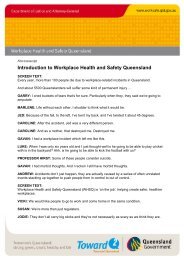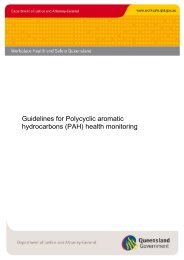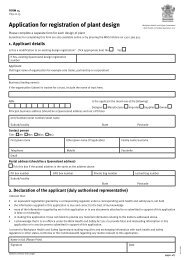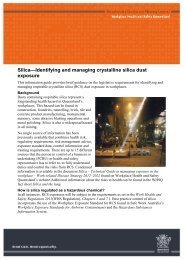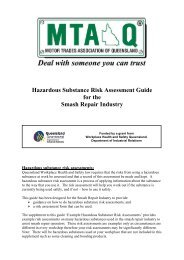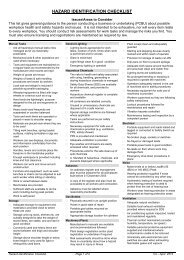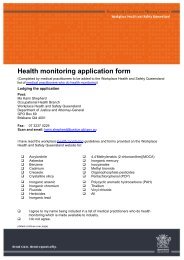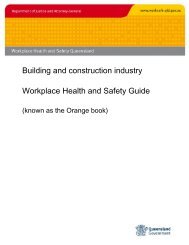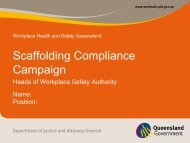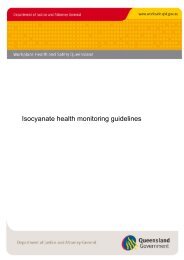Guide to working safely in people's homes - Queensland Government
Guide to working safely in people's homes - Queensland Government
Guide to working safely in people's homes - Queensland Government
You also want an ePaper? Increase the reach of your titles
YUMPU automatically turns print PDFs into web optimized ePapers that Google loves.
Workplace health and safety obligations<br />
Who has obligations?<br />
The relevant person who is an employer (as a service<br />
provider, or host employer of subcontrac<strong>to</strong>rs or agency<br />
staff), has an obligation under the Workplace Health and<br />
Safety Act 1995 <strong>to</strong> provide a healthy and safe workplace<br />
for themselves, their workers, <strong>in</strong>clud<strong>in</strong>g agency staff and<br />
subcontrac<strong>to</strong>rs, and anyone else <strong>in</strong> the workplace.<br />
The workplace for this <strong>in</strong>dustry <strong>in</strong>cludes:<br />
• private <strong>homes</strong> (e.g. a house, unit or caravan)<br />
• residential care <strong>homes</strong><br />
• other community sett<strong>in</strong>gs.<br />
Workers, <strong>in</strong>clud<strong>in</strong>g subcontrac<strong>to</strong>rs or agency staff, also<br />
have an obligation <strong>to</strong>:<br />
• comply with <strong>in</strong>structions given by the employer<br />
relat<strong>in</strong>g <strong>to</strong> the delivery of the care plan<br />
• only undertake activities that have been agreed <strong>to</strong> <strong>in</strong><br />
the client service agreement<br />
• wear personal protective equipment (PPE) and be<br />
tra<strong>in</strong>ed <strong>in</strong> its use.<br />
How <strong>to</strong> meet the obligations<br />
Service providers must conduct a risk assessment <strong>in</strong> the<br />
home, before provid<strong>in</strong>g any service <strong>to</strong> the client, <strong>to</strong> identify<br />
potential hazards and put appropriate controls <strong>in</strong> place <strong>to</strong><br />
reduce the risk of <strong>in</strong>jury or illness for clients, carers and<br />
other workers.<br />
The risk assessment must follow the five-step risk<br />
management process (see Figure 1 below) and be done <strong>in</strong><br />
collaboration with clients, their families and/or landlords.<br />
Control measures should also be identified while<br />
develop<strong>in</strong>g the client’s care plan.<br />
Figure 1<br />
Step 5:<br />
Moni<strong>to</strong>r and<br />
review<br />
Step 4:<br />
Implement control<br />
measures<br />
Step 1:<br />
Identify hazards<br />
Consultation<br />
should be carried<br />
out at each step<br />
of this process<br />
Step 2<br />
Assess and<br />
prioritise risks<br />
Step 3:<br />
Decide on control<br />
measures <strong>in</strong>clud<strong>in</strong>g<br />
hierachy of control<br />
Workplace Health and Safety <strong>Queensland</strong> | Department of Justice and At<strong>to</strong>rney-General<br />
<strong>Guide</strong> <strong>to</strong> <strong>work<strong>in</strong>g</strong> <strong>safely</strong> <strong>in</strong> people’s’ <strong>homes</strong>. PN10797 Version 3 Last updated February 2011<br />
If the assessment shows that workers are exposed <strong>to</strong><br />
significant risks, service providers will determ<strong>in</strong>e whether<br />
they need <strong>to</strong> modify or suspend that particular service<br />
until the risk has been adequately controlled. Client<br />
advocacy groups are available <strong>to</strong> work with all parties <strong>to</strong><br />
address the issues.<br />
Who has responsibilities <strong>to</strong> workers when<br />
<strong>work<strong>in</strong>g</strong> <strong>in</strong> the home environment?<br />
Employers (as service providers, or host employers of<br />
subcontrac<strong>to</strong>rs or agency staff), clients and/or primary<br />
carers and their families should work <strong>to</strong>gether <strong>to</strong> provide a<br />
safe environment for workers.<br />
Employers (as service providers, or host employers of<br />
subcontrac<strong>to</strong>rs or agency staff) should:<br />
• clearly communicate and understand what services<br />
are <strong>to</strong> be provided<br />
• assess additional services before be<strong>in</strong>g performed<br />
• review an activity that may have changed <strong>to</strong> ensure the<br />
controls are still <strong>work<strong>in</strong>g</strong> or need <strong>to</strong> be altered<br />
• document the daily moni<strong>to</strong>r<strong>in</strong>g of the service us<strong>in</strong>g<br />
various methods (e.g. a communication folder/book<br />
or electronically) particularly where there are several<br />
service providers or several community workers for a<br />
particular client.<br />
Clients and/or primary carers should:<br />
• ma<strong>in</strong>ta<strong>in</strong> a safe work environment (e.g. repair broken<br />
steps, mow long grass, restra<strong>in</strong> animals, provide<br />
adequate light<strong>in</strong>g)<br />
• look after their own <strong>in</strong>-home safety (e.g. ma<strong>in</strong>ta<strong>in</strong><br />
electrical equipment and <strong>in</strong>stall smoke alarms and<br />
safety switches <strong>to</strong> switchboards)<br />
• cooperate with service providers and workers<br />
<strong>to</strong> ensure safe work procedures and a safe work<br />
environment (e.g. move furniture <strong>to</strong> allow adequate<br />
work space, use lift<strong>in</strong>g equipment based on assessed<br />
needs)<br />
• keep their equipment safe, well ma<strong>in</strong>ta<strong>in</strong>ed and <strong>in</strong><br />
good order<br />
• <strong>in</strong>form service providers and others of any known<br />
hazards.<br />
5





